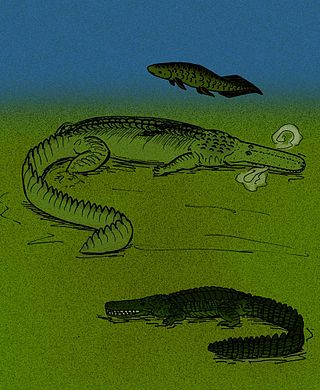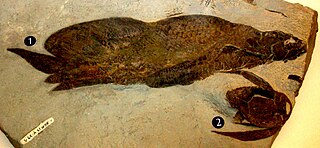
Sarcopterygii — sometimes considered synonymous with Crossopterygii — is a clade of vertebrate animals which includes a group of bony fish commonly referred to as lobe-finned fish. These vertebrates are characterised by prominent muscular limb buds (lobes) within their fins, which are supported by articulated appendicular skeletons. This is in contrast to the other clade of bony fish, the Actinopterygii, which have only skin-covered bony spines supporting the fins.
Gosfordia is an extinct genus of prehistoric lungfish known from the Triassic of Australia.
Eoctenodus is an extinct genus of prehistoric sarcopterygian or lobe-finned fish.
Devonosteus is an extinct genus of prehistoric marine lobe-finned fish known from the Late Devonian. It contains a single species, D. proteus from the late Frasnian of Wildungen, Germany. It has sometimes been considered a lungfish of the family Holodontidae, but this remains uncertain as the original specimen may be lost. Alternatively, it may be a tristichopterid, a type of basal tetrapodomorph.

Laccognathus is an extinct genus of amphibious lobe-finned fish from Europe and North America. They existed from the Middle Devonian to the Late Devonian. The name comes from Greek for 'pitted jaw'.
Holodipterus is an extinct genus of prehistoric sarcopterygian or lobe-finned fish.
Hainbergia is an extinct genus of prehistoric sarcopterygian or lobe-finned fish.
Hamodus is an extinct genus of prehistoric sarcopterygian or lobe-finned fish.
Oervigia is an extinct genus of lungfish in the family Rhinodipteridae from the Devonian of Greenland.
Mioceratodus is an extinct genus of lungfish in the family Neoceratodontidae, which also contains the extant Queensland lungfish. It is known only from Oligocene and Miocene-aged sediments in Australia, although phylogenetic evidence supports it having first diverged from its closest relative, Neoceratodus, during the Late Jurassic or Early Cretaceous period.
Metaceratodus is an extinct genus of prehistoric lungfish in the family Ceratodontidae, with an indeterminate specimen known from the Late Triassic (Norian)-aged Lissauer Breccia of Poland and more complete specimens known from the Late Cretaceous of Queensland, Australia and Argentina. The genus was named and described by Frederick Chapman in 1914.
Sagenodus is an extinct genus of prehistoric lungfish. It is a lungfish from the Permo-Carboniferous period found in Europe and North America.
Rhinodipterus is an extinct genus of prehistoric dipnoan sarcopterygians or lobe-finned fish, that lived in the Devonian Period, between 416 and 359 million years ago. It is believed to have inhabited shallow, salt-water reefs, and is one of the earliest known examples of marine lungfish. Research based on an exceptionally well-preserved specimen from the Gogo Formation of Australia has shown that Rhinodipterus has cranial ribs attached to its braincase and was probably adapted for air-breathing to some degree as living lungfish are. This could be the only case known for a marine lungfish with air-breathing adaptations.

Retodus is an extinct genus of prehistoric lungfish found in Cretaceous-aged freshwater strata of Egypt, Algeria and Niger. The type species, R. tuberculatus, was named in 2006. It was originally named as a species of Ceratodus and Neoceratodus in 1963.
Pentlandia is an extinct genus of prehistoric sarcopterygians or lobe-finned fish. Its first discovered species was initially named Dipterus macroptera by Ramsay Traquair in 1888, then renamed Pentlandia macroptera by D.M.S. Watson and H. Day in 1916.

Paraceratodus is an extinct genus of prehistoric lungfish. Only one species, P. germaini, is known from the latest Permian or earliest Triassic period of Madagascar. Phylogenetic evidence supports it being the most basal member of the suborder Ceratodontoidei, which contains modern lungfish, and as with the rest of the order it likely diverged during the late Carboniferous.
Orlovichthys is an extinct genus of prehistoric sarcopterygians or lobe-finned fish. Fossil evidence was found in Russia, and is from the Late Devonian period.
Tranodis is an extinct genus of prehistoric sarcopterygians or lobe-finned fish. It was a lungfish from the Upper Mississippian of North America.
Straitonia is an extinct genus of prehistoric sarcopterygian, or lobe-finned fish.

Scaumenacia is an extinct genus of lungfish. It lived around the Devonian in North America alongside another prehistoric lungfish: Fleurantia. It lived from approximately 384 to 376 millions of years ago.






